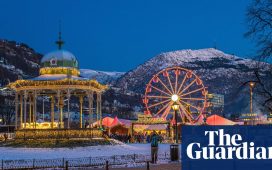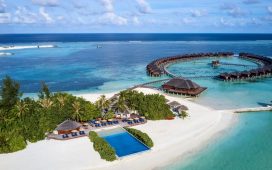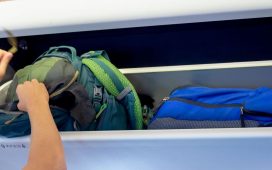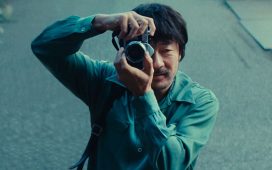Old-school glamour in Italy
Marketing slogans usually leave me cold, but even I can’t argue with “Queen of the Dolomites”, the sobriquet given to Cortina d’Ampezzo. There’s a regal air about this venerable ski resort in the Veneto region’s north-west, epitomised by its classy Corso Italia, a pedestrianised thoroughfare and favourite passeggiata meeting place.
But it’s those massive Dolomites that get me every time – hulking great chunks of limestone and sedimentary rocks streaked with snow and rising through the Ampezzo valley that turn a delicate shade of pink when the sun goes down.
Many people drawn to Cortina’s old‑school chic and glamour come here to shop, eat, drink and stroll the pretty streets. That leaves more room on the mountains for people like me to ski, snowshoe and hike amid the beauty of these peaks.
Cable cars and gondolas run up to several of Cortina’s highest peaks, including 3,244-metre Tofana di Mezzo (featured in the 1981 James Bond film For Your Eyes Only), with its fabulous views from the observation deck. I jumped off at Ra Valles, the penultimate stop on the cable car, for a hot chocolate at what was billed as the highest pizzeria in Europe (2,470 metres) with a vantage point of the towering peaks.
For skiers, the Super 8 is a top draw. The figure-of-eight circuit is definitely for intermediates and above, but non-skiers can get a taste of its stupendous scenery by taking a chairlift from Bai de Dones to Cinque Torri – not just five towers, as the name suggests, but 11 rocky columns in the midst of a snowy expanse – where there’s a snowshoe trail and Rifugio Scoiattoli has an outdoor hot tub (beds from €85pp).
For more wellness in the mountains Rifugio Lagazuoi at Lagazuoi (reached by gondola, €150 B&B) has one of the highest outdoor saunas (€25pp) in Europe. Like Cinque Torri, Lagazuoi and its surrounding peaks were the scenes of first world war battles between the Austro-Hungarian and Italian armies, and the tunnels and trenches have been restored to create evocative open-air museums.
Doubles at Cortina d’Ampezzo’s Hotel Columbia from €175 B&B
Mary Novakovich
A spa with a view in Austria
As the sun creeps over the shoulder of the Hohe Tauern mountains, the Gastein valley shimmers under a fresh blanket of snow. Wisps of cloud lift from dark veins of spruce forest to reveal a day like cut crystal. And I can see the whole lovely lot through the picture windows of my room at Haus Hirt in Bad Gastein, while wrapped in a robe, sipping coffee. Breakfast is until 11am. Let it wait.
On an eyrie-like perch above the treetops, Haus Hirt’s riveting views inspired writers Thomas Mann and Stefan Zweig in the 1930s. A cool revamp of an Alpine lodge, this intimate hotel brings together natural materials like larch wood and granite with a clean, modern aesthetic (courtesy of co-owner architect Ike Ikrath and Japanese interior designer Elma Choung). My days are happily spent between yoga, mood-boosting dips in the mountain-facing Aveda spa, and softly lit dinners.
Clinging to sheer, wooded cliffs, splashed by a raging waterfall with a vertical drop of 341 metres and peering up at some of Austria’s highest peaks, this spa town shot to fame in the 19th century for the healing powers of its radon-laced waters. Over three millennia, water has filtered through the deep rock layers of Hohe Tauern and now five million litres of it gush up from 17 springs every day. Schubert, Empress Elisabeth, Klimt and German painter Max Liebermann came here for the cure during the town’s belle epoque heyday.
I can see why Bad Gastein touched so many as I pad in quiet exhilaration through the Angertal valley on snowshoes, listen to snow fall softly from the trees, and float silently in the bath-warm thermal pools of Felsentherme Gastein as steam rises in the blue dusk and the mountains glow pearl white. Bad Gastein might be sky-high in the Alps, but you don’t have to whack on skis to enjoy its beauty – just tune into the peace of the winter landscape and let those miracle waters work their magic.
Accommodation was provided by Haus Hirt. Small doubles from €220 a night, full-board, haus-hirt.com
Kerry Walker
Sledging and snowshoeing in Switzerland
The Alpstein massif in the Appenzell Alps is where Switzerland most looks like a child’s drawing. In this region, 40 miles east of Zurich, steeple-like peaks and snow-brimmed barns are everywhere, and ghostly footprints disappear over snowbanks.
Every winter, I come here to ski, snowshoe, and eat meat and raclette cooked on a stone-slab steingrill, moving from Appenzell, the region’s main town, up into the mountains. Something about the place lends itself to micro adventures, and the Alpstein, topped out by Säntis at 2,501m, is a piece of pure Alpine theatre.
I’d recommend staying in a mountain guesthouse like Hoher Hirschberg, a cosy wooden place that looks like it hasn’t changed for centuries. Inside, above the pine-clad restaurant (the veal sausage with fried-onion-topped cheese spätzle is particularly good), are bright, simply furnished rooms. From the windows, you can see the ridged horns of the Alpstein, white in the distance, punching out of the valleys below. In deep snow, the last stretch of road to the guesthouse is closed, meaning a 150-metre uphill snowshoe is all part of check-in.
For a longer caper, a four-mile trail leads from near Appenzell through wooded foothills right to the guesthouse; the trick is to take a sledge with you to whizz back down again. Equally worthwhile from the valley floor is the two-mile snowshoe for lunch at Eggli, a historical working farm. If you’re having what I’m having, then it’s a Quöllfrisch Hell lager and wurst-käse salad, mixed with Appenzeller cheese and sausage.
Seven miles south of Hoher Hirschberg is the cable car to Ebenalp, the valley’s main ski area (return ticket £34). To the east, another cable car takes visitors to the summit of Hoher Kasten, which has a terrific revolving restaurant (£36 return). The summit path can be looped in half an hour, but I think it’s better to snowshoe the out-and-back four-mile circuit from the cable car base station to Plattenbödeli mountain guesthouse, which overlooks blue-grey Sämtisersee Lake, at 1,209m. The view, I think, is more beautiful than that of the Matterhorn.
Like most places in the Alpstein, you’ll be alone in the Plattenbödeli. At the lakeview restaurant, tuck into frying pan-sized rösti and chocolate cake doused in Säntis Malt whisky. Happily, that’s tapped from a muscatel barrel and made by Brauerei Locher, from where your adventure first began, down in the valley below, under the twinkling lights of Appenzell.
Plattenbödeli has doubles from £134 B&B, weekends only in January, February and April. Hoher Hirschberg has doubles from £134 B&B
Mike MacEacheran
The magic of winter in the Arctic Circle, Norway
I was cocooned in the hot embrace of a wood barrel sauna, the silence punctuated solely by the crackle and hiss of logs. From its glass-fronted end, I looked across the pewter shimmer of a freezing fjord. On the far side, afternoon light gilded the ridges of the snow-covered mountains. Later, I told myself, I would dip into that large ice bath and let the cold pinch my body pink and awake. But for now I would linger a while longer, revelling in that quiet hunkering down that belongs only to winter, and which Norwegians call kos.
Similar to the Danish concept of hygge, this ethos embraces the contrast of coldness and cosiness, of snowy romps followed by retreats around the fire. Both are on offer at Vesterålen Apartments, a trio of fjord-side self-catering houses offering “calm luxury in the wilderness” near Klakksjorda, a hamlet on the wild Vesterålen archipelago.
Located just north of the Lofoten islands, Vesterålen is far less visited but excels at winter magic. Up here, 200 miles north of the Arctic Circle, the polar night, from late November to late January, creates a lavender-hued daylight under which to try snowshoeing, a moose safari or kayaking. Plus, there’s a very good chance of seeing the aurora.
Henrik Hvashøj, the owner of the apartments, and his wildlife guide Ian Robins also take guests (dressed in windproof onesies) out on a rigid inflatable boat to feed mackerel to the five pairs of white‑tailed sea eagles that nest along this inlet. This parcel of shoreline has been in Henrik’s family for three generations; his mother’s photographs decorate the walls of the apartments.
I was exploring on a new trip with Discover the World and combined a stay here with an 80-minute drive north to the hamlet of Nyksund, which nestles at the bottom of Nyken mountain. Thirty years ago, this former fishing outpost was a ghost town. A band of 22 residents have slowly revived the car-free village, which is shared with a gaggle of kittiwakes and only has one lamp-post, so expect spectacular aurora displays.
In summer, there are day visitors, but coming in winter allows you to spend real time with locals and soak up the kos. I sipped coffee and snacked on hot waffles in the homely antiques cafe, Delpen, learned about two local female artists in the bijou Nyksund Art Gallery, joined a seal safari and did some spectacular hiking along a portion of the Queen’s Trail, a challenging nine-mile route through the Møkland mountains.
The trip was provided by Discover the World; the 7-night Around Vesterålen trip staying in Nyksund and Vesteralen Apartments costs from £1,451 per person
Emma Thomson
Skiing and song in the French Alps
It was a powder-soft descent to the glade looking down towards the Les Bellevilles valley, and I arrived outside the off-piste stone hut to find no one else around. There were few tracks in the snow and the only other sign of life was a wisp of smoke escaping from its chimney. I noted there was a large wood-fired hot tub, its top and steps covered by a fresh coat of snow. My pulse quickened. Next to it, hammered on to a handmade ornamental archway made from birch was a sign bearing one word. “Refuge”.
I was told about Le Trait d’Union refuge above Saint-Martin-de-Belleville a few years ago by a mountain guide who had lived in the Savoie all his life. Incredibly, tucked away in a forest at 1,725 metres, it is in the midst of Les 3 Vallées, the world’s largest ski area. Mega resorts Les Menuires and Val Thorens are further up the Tarentaise valley. Meribel is up-and-over the Roc de Fer, the “iron rock” col, with a downhill piste roller coasting down the opposite side.
All of this explosive topography means there are winter activities galore, for all ages and abilities. Cross-country skiing, snowshoeing, dog-sledding, tobogganing, ice climbing and ski touring are sacred native rituals here.
Inside the refuge there are three cosy bedrooms up a tight staircase above the counter-bar and tiny restaurant, both of which are open to non-guests, too. You can rise early, then ski or snowshoe before even the cockerels have begun to stir. Later, there is time for little else but a soak in the Nordic tub and stargazing while looking over the valley to the ridges beyond.
The idea, said owner Vivian Hudry, was to turn what was once a family cottage into something that would give her a renewed sense of purpose. “There’s an element of selfishness about what I do,” she said. “After I lost my husband, it was very difficult to have this place with nothing in it. It was for us, then it was empty. I lost all sense of my life. Now people who come to stay are bringing that life back.”
Indeed, it’s a fun place to be. At lunch, a plate of diots aux crozets (buckwheat pasta topped with wine-boiled sausage) arrived and Vivian turned entertainer, handing out lyric sheets like a Sunday School minister and beginning with a rousing rendition of popular 1930s song Étoile des Neiges on her accordion. Soon, the little refuge was full of song from French skiers and holidaymakers. La Vie en Rose followed, then several shots of génépi, a herb-based Savoie aperitif. After that and a starlit soak in the tub, dinner is a similar, if far sleepier, affair. Next time, I’ll remember to drink more water, less wine.
In this supernova of a valley, with every kind of stylish hotel, self-catering apartment, ski package and swanky nightclub, it felt to me as though this was the Tarentaise on rewind. And what an absolute thrill.
Trip provided by Saint-Martin-de-Belleville. Rooms sleeping four at Refuge le Trait d’Union from €95pp, half board (two-night minimum). One-day ski pass from €64 for the combined ski area of Les Menuires/Saint-Martin-de-Belleville
Mike MacEacheran
Snowy hikes in Slovenia
I was riding so fast it felt like flying. Around me the Julian Alps soared upwards, their snow-covered peaks reflected below us in the glacial lake. Icelandic horses are incredibly sure-footed, perfect for exploring this mountainous terrain.
Based at Lake Bohinj, about 50 miles from the capital Ljubljana, I’d come here for a reset. I’d chosen well: this is where Slovenians holiday, and it’s particularly lovely in winter.
We had been riding for a couple of hours across the valley and up into the mountains, and paused to give the horses a rest, although my pony, Lila, showed no signs of fatigue. The Vogel resort is nearby, reached by cable car from the lake, and one of the more affordable places to ski in Europe, but for non-skiers there are magical snowy hikes to be had.
The forests surrounding the huge glacial lake are home to bears, wolves and lynx, and local guide Grega Šilc took me out as fresh snow was falling. We walked for hours, following the course of the River Mostnica to the waterfall at the end of the Voje valley, stopping on the way back at a mountain hut for coffee and a slice of blackberry pie. The snow muffled all noise in these ancient woods. Although we didn’t glimpse any spectacular wildlife, it was one of the loveliest hikes I’ve been on. In the distance I could see 2,243-metre Draški Vrh peak. As Grega said: “It looks like a mountain children would draw.” He also said that for cross-country skiing, Pokljuka plateau, just above Bohinj valley, is the place to go.
Accommodation options in the villages around the lake include cosy self-catering chalets and traditional mountain huts for a more rustic stay (bring cash as they often don’t accept cards). But after being out in the cold all day, retreating to Hotel Bohinj felt like a well-earned treat. Right on the lake shore, it’s new, very comfortable and beautifully designed, and it has a spa. A fire was blazing in the lobby and sheepskin furs were everywhere, but my favourite spot was a tiny library on the mezzanine level where I stretched out my sore legs and enjoyed a glass of Slovenian wine. Outside, the snow was falling into the lake, and I watched the outlines of the mountains turn charcoal in the darkness.
The trip was provided by the Slovenia Tourist Board and Hotel Bohinj (doubles from €150 B&B)
Laura Coffey














